Here's some pics of the external oil cooler I installed on the Snow Trac's vw engine. The oil lines route oil from an aftermarket full-flow oil pump behind the crank pulley, through a mechanical thermostat (H-shaped casting attached to braided hoses), and through an oil cooler mounted in the front grill. An oil filter housing and thermostat sandwich adapter will take the place of the thermostat. A mechanical thermostat allows cold oil to bypass the cooler and filter during warmup, allowing the oil to warm to 180ºF before opening. The thermostat also prevents cold, viscous oil from blowing out the filter body/seal, and prevents possible bursting of the oil cooler as cold oil pressure in VW engines can reportedly reach 300 psi upon starting. There's also an inline thermostat for the cooling fan on the outflow side of the cooler. When the oil cooler alone is not able to cool the oil to 196ºF, then the fan kicks on. Some people make the mistake of installing the thermostat on the inflow side of the cooler. The result is overcooled oil returning to the engine block.
The system works well, and probably gives better oil Tº control than the stock VW oil cooler and thermostat. So far, I've not exceeded 190º so the fan hasn't been necessary. Nice to know it's there though.
The system works well, and probably gives better oil Tº control than the stock VW oil cooler and thermostat. So far, I've not exceeded 190º so the fan hasn't been necessary. Nice to know it's there though.

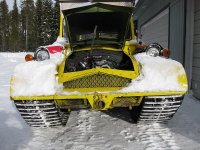
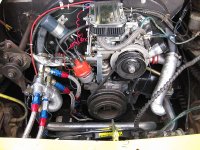
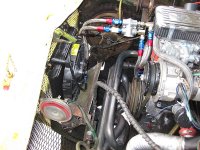
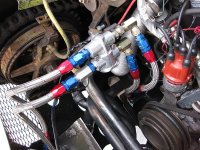
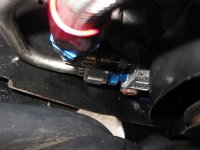
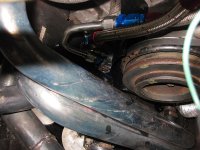
 ? I took your advice and actually punched those holes last winter hoping that it would result in the needed cooling after I installed the new engine. In my case, it wasn't enough but undoubtedly helped cool the engine compartment. These pics were taken with the engine pan removed, but I also put heat-reflecting cloth on the bottom side of it. My hope was to reflect some of the header heat out through the large holes in the belly pan. This undoubtedly helped an incremental amount, but no siginificant improvement was seen until I did the cooler mod.
? I took your advice and actually punched those holes last winter hoping that it would result in the needed cooling after I installed the new engine. In my case, it wasn't enough but undoubtedly helped cool the engine compartment. These pics were taken with the engine pan removed, but I also put heat-reflecting cloth on the bottom side of it. My hope was to reflect some of the header heat out through the large holes in the belly pan. This undoubtedly helped an incremental amount, but no siginificant improvement was seen until I did the cooler mod.
